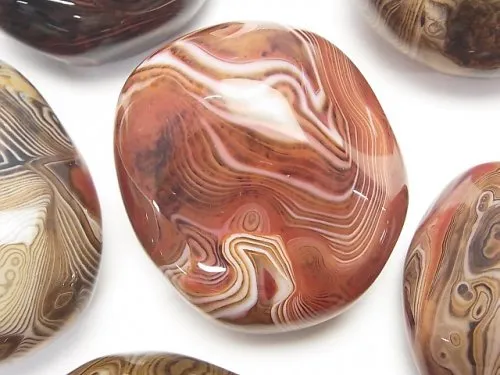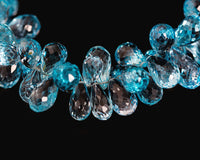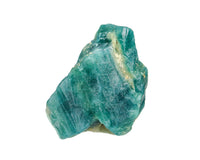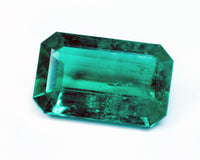- 1. Agate
- 2. The History and Meaning of Agate
- 3. Chemical-Physical Properties of Agate
- 4. Types of Agates
- 4-1. Crazy Lace Agate
- 4-2. Onyx Agate
- 4-3. Sardonyx Agate
- 4-4. Moss Agate
- 4-5. Dendrite Agate
- 4-6. Floral Agate (Flower Agate)
- 4-7. Fire Agate
- 4-8. Botswana Agate
- 4-9. Indian Agate
- 4-10. Tibetan Agate
- 5. Healing Properties of Agate
- 6. Metaphysical Properties of Agate
- 7. Agate for Sale from KenKenGems
Agate
Want your gemstone to display mountains, lakes, plants, landscapes, or eccentric pictures? Then you just can’t deprive agates of your attention. These unique stones are in a league of their own when it comes to the wealth of patterns and color combinations.

The History and Meaning of Agate
Agate is an ancient mineral first mentioned in the 3rd century BC. It is believed that the Greek philosopher Theophrastus, who was the first to describe the stone, named it after the Achates River in Sicily. According to another version, the name of the mineral comes from the Greek ‘agates’ meaning happy.
Agate crafts and jewelry were found in Egyptian tombs as well as ancient burials in England and the Urals. Our ancestors believed that the stone could ward off storms. It was placed under pillows to allow sleepers to see vivid dreams. The stone incorporated into a ring gave prudence, and agate inlays in earrings could protect from negative thoughts. The ancient Romans associated it with the goddess of fertility Ceres. Every Roman farmer and gardener had agate stones. They placed them in their gardens to protect the crop from bad weather.

Chemical-Physical Properties of Agate
Agate is a volcanic gem that occurs as a result of the accretion of various minerals of the silica family (SiO2), with chalcedony being a dominant mineral. Most commonly, it has a layered structure in the form of bands or concentric stripes. These layers come in different colors and can have varying degrees of translucency. Thanks to this, cross-section cuts reveal original, never-repeating patterns.
The hardness of agate is 6.5-7.0 on the Mohs scale. After polishing, its surface acquires a glassy luster, although the fracture is more matte and waxy. Agate can be partially translucent or completely opaque.
The variety of colors and fancy ornaments appear due to the gradual layering of chalcedony as well mineralization of voids. Such minerals as rock crystal or hematite fill hollows and cracks in mother rock. Agate’s decorative properties and ease of cutting make it highly valued among jewelers.

Types of Agates
Agate is one of the few gems that boast a huge range of colors and patterns. Therefore, it is simply impossible to clearly answer the question “What does agate look like?” The thing is that there are more than a hundred variations of the gem.
The stone’s most common colors are milky, white, blue, gray, then yellow, pink, and black. We can’t provide a comprehensive list of agate types but below, are some of the most noteworthy:
Crazy Lace Agate

Crazy lace agate, otherwise known as Mexican agate, provides complex banded and swirly patterns that either come from a single point or multiple centers. Thanks to infusion with iron and aluminum, these bands display brown, beige, gray, black, gold, and many pastel colors.
Onyx Agate

Onyx agate - while onyx itself will provide black and white bands, agate is more generous since its offers every color of the rainbow. Unlike other specimens of agate, layers of chalcedony are arranged parallel to each other.
Sardonyx Agate

Sardonyx agate - banded patterns of this type are sards, i.e. they have reddish colors (orange, yellow, tanned, brown, plus black and white).
Moss Agate

Moss agate is a translucent green-gray gemstone that displays clusters of iron or manganese oxide or chalcedony banding resembling moss.
Dendrite Agate

Dendrite agate features a pattern of intricately intertwined tree branches.
Floral Agate (Flower Agate)

Floral agate (Flower Agate) is a variety of moss or dendrite agate distinguished by brightly colored inclusions.
Fire Agate

Fire agate features a banded rainbow effect combined with shimmering, as if burning, particles of hematite.
Fortification agate got its name because of the multitude of concentric layers, which resemble defensive structures from a bird's eye view.
Iris agate is perhaps the most striking type thanks to multiple bands of all possible colors. However, the stone reveals its patterns only when bright natural light hits its surface.
Star agate is a rare variety that displays a 4-, 6- or 12-beamed star when being cut en cabochon.
Landscape agate is a very beautiful type of agate displaying pictures of nature made up by the duets of contrasting colors. Landscape agates have their own varieties such as ruins and clouds.
Rainbow stones have ultra-thin layers that spread out sunlight to display every color of the rainbow;
Some types of agates are named after the place of mining:
Botswana Agate

Botswana agate is an expensive type of agate in gray or pink colors.
Indian Agate

Indian agate is green and brown.
Tibetan Agate

Tibetan agate is a marbled black and white mineral.
Brazilian agate has gray, white, and brown concentric layers.
African agate is a refined variety obtained in the process of heating and rapid cooling. This results in a mesh of cracks, which are then tinted to become the so-called ‘dragon veins’
Healing Properties of Agate
The stone of longevity and health - this is how agate was called in ancient times. The medicinal properties of the gem largely depend on its. Lithotherapy states that gray-white agates have a general strengthening effect on the body. You can maximize this effect if you wear agate bracelets. Blue agate positively influences the thyroid gland while yellow stones treat the diseases of the throat and liver. Red gems alleviate the symptoms of cardiovascular diseases - it is best to flaunt them on the ring finger of the left hand. Black agate patronizes males since it is able to promote potency.
Metaphysical Properties of Agate
The stone’s volcanic origin endowed it with powerful energy. Healers and sorcerers consider agate to be their patron. In Ancient Egypt, agate had the meaning of a fertility stone, in medieval Europe, it was a symbol of prosperity and health, and Indians valued it for its ability to promote well-being.
The metaphysical properties of agates are strong and varied. When opting for this beautiful mineral, you can count on:
•protection from losses and unnecessary expenses;
•enhancing of spiritual growth and guarding against lack of energy;
•enhancing self-confidence and eloquence;
•assisting in decision-making;
•providing hope and strength to move on or start all over again.
Agate is capable of helping you understand yourself, solve problems, and improve your productivity. The properties of the stone make it a symbol of harmony as well as a healthy body and sound mind.
Agate for Sale from KenKenGems
If you want to craft stunning but inexpensive jewelry, agate is your best bet. Here, at KenKenGems, we supply dozens of varieties of this volcanic stone including Mexico fire agate, moss agate, crazy lace agate... the list can go on and on. You can get these agates in the form of strands, individual one-of-a-kind stones, pendants, and loose stones. With a focus on quality and wealth of choices, KenKenGems is a one-stop-shop for agates meeting all your needs.







